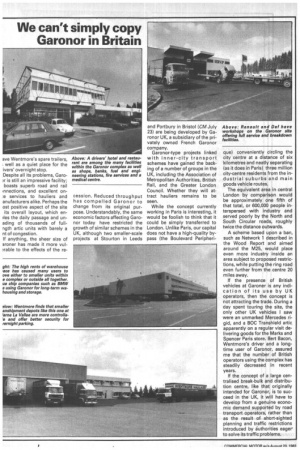We can't simply copy Garonor in Britain
Page 48

If you've noticed an error in this article please click here to report it so we can fix it.
ave Wentmore's spare trailers, well as a quiet place for the ivers' overnight stop.
Despite all its problems, Garo)r is still an impressive facility; boasts superb road and rail rnnections, and excellent on:e services to hauliers and a nufactu rers alike. Perhaps the ost positive aspect of the site its overall layout, which endes the daily passage and unading of thousands of fullngth artic units with barely a nt of congestion.
If anything, the sheer size of aroner has made it more vulrable to the effects of the re
cession. Reduced throughput has compelled Garonor to change from its original purpose. Understandably, the same economic factors affecting Garonor today have restricted the growth of similar schemes in the UK, although two smaller-scale projects at Stourton in Leeds and Portbury in Bristol (CM July 23) are being developed by Garonor UK, a subsidiary of the privately owned French Garonor company.
Garonor-type projects linked with inner-city transport schemes have gained the backing of a number of groups in the UK, including the Association of Metropolitan Authorities, British Rail, and the Greater London Council. Whether they will attract hauliers remains to be seen.
While the concept currently working in Paris is interesting, it would be foolish to think that it could be simply transferred to London. Unlike Paris, our capital does not have a high-quality bypass (the Boulevard Peripheri quo) conveniently circling the city centre at a distance of six kilometres and neatly separating (as it does in Paris) three million city-centre residents from the industrial suburbs and main goods vehicle routes.
The equivalent area in central London by comparison would be approximately one fifth of that total, or 600,000 people interspersed with industry and served poorly by the North and South Circular roads, roughly twice the distance outwards.
A scheme based upon a ban, such as Network I described in the Wood Report and aimed around the M25, would place even more industry inside an area subject to proposed restrictions, while putting the ring road even further from the centre 20 miles away.
If the presence of British vehicles at Garoner is any indication of its use by UK operators, then the concept is not attracting the trade. During a day spent touring the site, the only other UK vehicles I saw were an unmarked Mercedes rigid, and a BOC Transhield artic apparently on a regular visit delivering goods for the Marks and Spencer Paris store. Bert Bacon, Wentmore's driver and a longtime user of Garonor, assured me that the number of British operators using the complex has steadily decreased in recent years.
If the concept of a large centralised break-bulk and distribution centre, like that originally intended for Garonor, is to succeed in the UK, it will have to develop from a genuine economic demand supported by road transport operators, rather than as the result of short-sighted planning and traffic restrictions introduced by 6uthorities eager to solve its traffic problems.
















































































